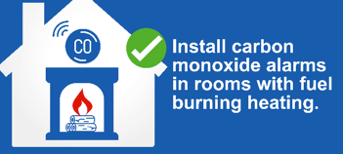Carbon Monoxide (CO) Alarms

Carbon monoxide (CO) is a silent and deadly gas that can be emitted by malfunctioning or improperly vented fuel-burning appliances.
Carbon Monoxide Alarms
Carbon monoxide detectors, commonly known as CO alarms, are devices specifically designed to detect the presence of this odourless and invisible gas. They serve as an early warning system, alerting occupants to dangerous levels of CO in their homes. Every household should have at least one CO alarm installed, with additional units recommended for each floor, near sleeping areas, and in proximity to potential CO sources such as gas appliances, wood-burning stoves, or attached garages.
Who needs a CO alarm?
If you live in a house or flat that’s entirely powered by electricity, you won’t need a carbon monoxide detector. But if you have a fuel (gas, LPG, oil, wood) burning boiler, fire or stove, you should have one in every room where fuel is burned.
Tips for staying safe with CO alarms:
- Install CO alarms on the wall or ceiling according to the manufacturer's instructions.
- Mount them at a height of 1-3 meters above the ground, away from any obstacles or ventilation sources, and make sure they are easily audible from all areas of the house.
- Avoid placing them in areas with high humidity or in direct sunlight, as this can affect their performance.
- Choose approved and certified alarms.
- Look for one that meets the British Standard BS EN 50291 to ensure its effectiveness is guaranteed.
- Buy your alarms from a reputable source and check for the British Standard mark on the packaging.
- Know the Difference Between CO and Smoke Alarms.
- CO alarms are specifically designed to detect carbon monoxide, while smoke alarms are designed to detect smoke and fire.
- They are not a substitute for one another and both types of alarm should be installed in your house.
- Test alarms at least one per month
- Most CO alarms come with a test button for simple verification of their operation.
- Follow the manufacturer's instructions for testing procedures.
- Replace the batteries in your CO alarms at least once a year or as recommended by the manufacturer, even if the alarm is wired to the electrical system.
- Install long-lasting, tamper-proof batteries.
- Regularly clean your CO alarm
- Remove any dust or debris that may hinder their functionality, in accordance with manufacturer guidelines.
- Replace the detector according manufacturer recommendations, usually every 5-7 years.
- CO alarms have a limited lifespan and may lose sensitivity over time.
- Regularly service and maintain any combustion appliances such as gas boilers, stoves, or fireplaces according to the manufacturer's instructions.
- Have these appliances inspected by a qualified professional annually.
- If your CO alarm sounds or if you suspect the presence of carbon monoxide in your home due to symptoms such as headaches, dizziness, or nausea, take immediate action.
- Leave your home, call 999, and seek medical attention.
- Do not re-enter your home until it has been deemed safe by professionals.
- Ensure that all household members, including children, are aware of the sound and meaning of a CO alarm.
- Teach them the importance of responding promptly to a CO alarm and evacuating the premises safely.
- Regularly discuss CO safety with your family and develop an emergency plan.